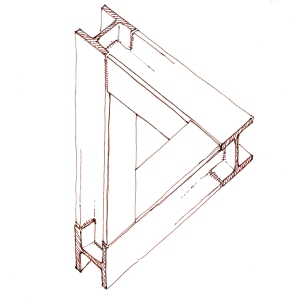Footing
Una zapata es cimentación superficial o semiprofunda (clasificación de las cimentaciones) formada por una pieza prismática de hormigón, armado o en masa, de planta cuadrada o rectangular (aunque también puede tener otras) que, situada bajo uno o varios pilares (generalmente uno y raramente más de dos), transmite la carga de estos y su propio peso al terreno.
A footing is a shallow or semi-deep foundation (classification of foundations) consisting of a prismatic piece of concrete (reinforced or mass), square or rectangular in shape (although it can also have another shape) which is placed at the base of one or more columns (normally one and in a few cases more than two) and transmits its own weight and the loads of these to the ground.

Construction detail of a reinforced concrete footing.
En los planos de un proyecto, los detalles constructivos de las zapatas se complementan con dos tablas en las que se recogen sus dimensiones y armados y las esperas de los pilares. Como estos datos se indican en las tablas, repetirlos en un detalle más o menos tipo no procede, ya que serán diferentes dependiendo de cada tipo de zapata, por lo que simplemente hacemos referencia a su indicación en estas tablas.
Siguiendo el orden de colocación en obra, en el detalle indicaremos el hormigón de limpieza (que está regulado en el nuevo Código Estructural desde agosto de 2021); los separadores, que si se vierte una capa de hormigón de limpieza de 10 cm, conforme al ambiente XC2 serán 35 mm; y sobre estos, la armadura, que estará indicada en la tabla de zapatas. De esta armadura, indicaremos la altura de las patillas y la separación a las paredes laterales de la zapata que, si se hormigonan contra el terreno, no será menor de 7 cm.
Las esperas de los pilares dependen del armado de estos, por tanto, y como ya se ha dicho antes, se indican en el cuadro de armado de los pilares.
In the plans of a project, the construction details of the footings are complemented by the indications of two tables of two tables indicating their dimensions and reinforcements, and the starting bars of the columns. As these data are given in the tables, repeating them in a standard detail makes no sense because they will be different depending on the particular type of footing. So, the correct is to make a reference to these tables.
According to the order of construction on site, we indicate the blinding concrete (regulated since August 2021 by the new Structural Code); the spacers, which can be 35 mm high for an XC2 environment if there is 10 cm high blinding concrete; and the reinforcement on top of these; which are indicated in the table of footings. The height of the anchorages of these reinforcements and the spacing of the side walls shall be indicated, which, if the footing is concreted against the ground, shall not be less than 7 cm.
The starting bars of the columns depend on the column reinforcements, and are indicated in the column table as mentioned above.
En el detalle constructivo, el hormigón de limpieza está indicado como HL-15 cuando debería haberse rotulado HL-150. Desde la antigua EHE-08, y ahora el Código Estructural, el hormigón de limpieza se denomina por su dosificación de cemento: 150 kg/m3.
Cleaning concrete is indicated in the construction detail as HL-15 when it should have been labelled HL-150.Since the old EHE-08, and now the Structural Code, the cleaning concrete is called by its cement dosage: 150 kg/m3.


Pingback: Solera arriostrante – Dibujando Hierros
Pingback: Viga de cimentación – Dibujando Hierros
CLaros y muy didacticos los ejemplos expuestos, a destacar la importancia del dibujo «a mano» que se ha perdido
Muchas gracias por tu comentario. Es todo un apoyo para seguir dibujando.
Pingback: Zapata corrida escalonada – Dibujando Hierros
Pingback: Placa de anclaje con pernos atornillados – Dibujando Hierros
Pingback: Sustitución del saneamiento embutido en una losa de cimentación – Dibujando Hierros
Pingback: Zampeado – Dibujando Hierros
Pingback: Sección por fachada del forjado sanitario – Dibujando Hierros
Pingback: Predimensionado de cimentaciones por zapatas – Dibujando Hierros